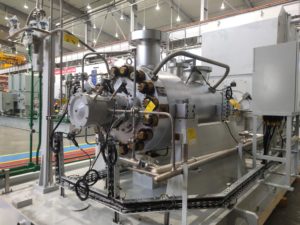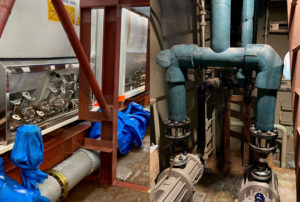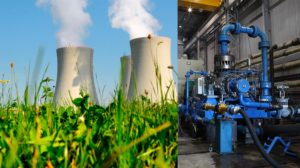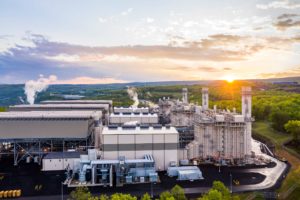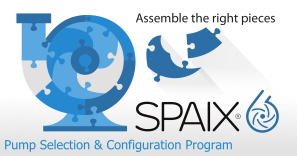Carbon Dioxide: Climate Killer or Raw Material?
In the context of the "Green Technologies Day" event series initiated by Lewa, at the end of March participants were intensively discussing the question of whether CO2 should be seen as a climate killer or a raw material.
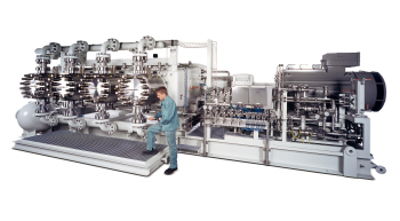
Lewa process diaphragm pump in use on the Snøhvit gas field for the reinjection of CO2. (Image: Lewa)
Current research activities involving the capture and storage of carbon dioxide during natural gas extraction and the operation of coal-fired power plants were examined, as well as established procedures and techniques for the industrial utilization of carbon dioxide (extraction with supercritical CO2, purification tasks, foaming of plastics). High-pressure pumps play a substantial role in all these processes.
One example are the application possibilities of supercritical CO2. Its excellent solution properties are commercially used, for example, in the extraction of natural compounds (coffee, tea, hops) and the separation of temperature-sensitive materials. By adjusting pressure and temperature, it is possible to find the ideal density to achieve high solubility. This can increase extraction rates or make substances that are insoluble in conventional solvents accessible to extraction.
Lewa is also involved in processes for the working of contaminated soils, the degreasing/deoiling of workpieces, and the separation of grinding sludges. Other processes, some implemented in industrial practice and some still in development, are for example textile cleaning or textile dying with supercritical CO2.
The challenge to the pump manufacturer is this: In addition to the compressibility of liquid gases, which has a significant influence on the efficiency of the pump at higher pressures, the compression heat that arises also plays a crucial role. The surface within the pump head heats up. If CO2 is present at vapor pressure, this can cause cavitation in the suction stroke that leads to a loss of pumping efficiency. To counteract this effect, the suction line or the pump head – or both – are cooled.
Another interesting use of CO2 is in the foaming of plastics – here, Lewa is a leader as a complete system supplier. The task in this case is the reliable, low-pulsation metering of the foaming agent (CO2, propane, butane, propane/butane mixtures, halogenated hydrocarbons) into a plastic melt at pressures between 250 and 500 bar.
Since the foaming agent metering has a fundamental influence on the quality of the end product (insulation properties, density, pore size), systems for the foaming of plastics are usually designed as self-monitoring systems. The characteristic value of the metering pump is generally the RPM of the extruder. The metering pump, frequently designed as a duplex or triplex pump, introduces a quantity of foaming agent into the polymer melt that is proportional to the extruder speed. This regulation is handled by Lewa s FIS dialog.
At "Green Technologies Day", CO2 was also presented as a multipurpose agent for cleaning. The challenge: In fabrication under clean room conditions, even the smallest amount of contamination can have a negative influence on product quality. Many of the established cleaning processes reach their limits in these circumstances. The use of CO2 snow accelerated in a nozzle represents a purification alternative for numerous applications. This results from its combination of gentle abrasion, induction of thermal stress, solubility, and rinsing effect.
The advantages of the CO2 snow-jet process are also useful for the inline cleaning of blind holes. The solution approach of this cleaning process is first to remove oily residue from the drilled hole effectively by using supercritical CO2, to reduce the adhesive force of holding particles in the hole. Then the loosened particles can be blown out of the hole by the accelerated CO2 jet. Most residual auxiliary processing materials can be removed very well.
Power generation releases large quantities of CO2. About half of the power generated in Germany comes from coal. There are just a few options to reduce the resulting CO2 emissions – one of those options is to improve conversion efficiency. An increase in the efficiency of a power plant is the best way to reduce carbon dioxide.
The central disadvantage of CO2 capture and storage (CCS technology: Carbon Capture and Storage) that should also reduce CO2 emissions is clear: The loss in efficiency ranges from 8 to 13 percentage points. That means that implementation of CCS technology requires the combustion of larger quantities of coal to maintain the same power output.
CCS technology has already been used for a few years for the reinjection of fossil carbon dioxide occuring in natural gas fields. The CO2 contained in natural gas is captured, then injected into reservoirs or underground caverns. A very well-known CCS system is located in the Snøhvit gas field in Norway. Here, the 5 % to 8 % carbon dioxide contained in the harvested natural gas is subjected to a chemical absorption process to separate it from the raw gas, then compressed and liquefied, and finally pumped into the reservoir. The world s largest process diaphragm pumps, manufactured by Lewa, are used for the injection.
Summary: It is incorrect to view CO2 solely as a climate killer. The speakers at "Green Technologies Day" at Lewa showed convincingly that it is an extremely attractive compound that serves valuable purposes, for example for supercritical extraction, cleaning tasks, and foaming of plastics.
The emission of anthropogenically generated carbon dioxide is currently about 29 billion tons/year worldwide. The use of CO2 as an industrial gas, at about 20 million tons/year, or as a chemical raw material at about 110 million tons/year [1], is a rather restricted contribution to the reduction in carbon dioxide emissions. Its use as a raw material is still an important option in the overall strategy of carbon management.
Source: LEWA GmbH

